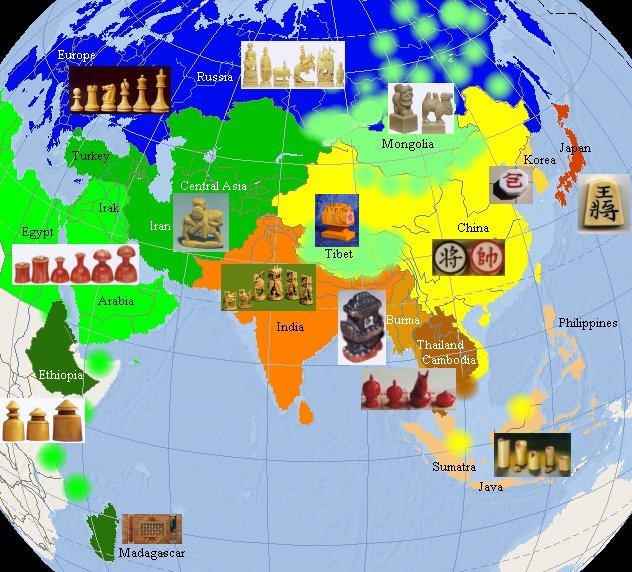Varieties of Chess in ancient world
As an evidence of a rich history, many different Chess co-exist in the World. Even if the International form of Chess is widely known and played in several Asian countries, they are some regional variations which are still very lively nowadays.
Xiangqi is played in China, in Vietnam (called Cò tuóng) and in several South-Asian countries (Singapore, Malaysia, etc.) It can be honored as the World's most played boardgame. It is estimated that more than 200 millions people play Xiangqi. Many occidental travelers have been abused while looking at a Xiangqi game : using tokens rather than carved relief pieces, it has been taken for Draughts rather than Chess. As a matter of fact, Xiangqi is a very nice Chess, seducing with its river, palaces, elephants and cannons.
In the neighboring Korea, people play Janggi which is a related form. The river has disappeared and the pieces, which are octagonal, have earned more moving power.
Japanese have their own variation, called Shogi which is very intriguing. They use an army of generals of different precious metals or jewels. Literally, Shogi means the game of the generals. Captured pieces are not merely removed ; they just switch side just as the Samurais used to do in the Shogun era when they were fierce mercenaries. For this reason, pieces are shaped to show their direction.
Xiangqi, Janggi and Shogi are not the only specific Asian varieties. In South-East, they are forms which have developed from an original Indian 2-Handed Chaturanga (there were a 4-Handed Chaturanga as well). Then, on an unicolor board and with boats and elephants, there are Sittuyin in Myanmar (Burma), Makruk or Ouk Chatrang in Thailand and Cambodia. There is also Main Chator in Malaysia and Indonesia, influenced by European rules.
Finally, in the Northern lands, there are Shatar and Hiashatar, played in Mongolia. It is not surprising to learn that in this country of dreadful riders who once submitted Eurasia from China to Hungary, the knight has enhanced powers. Other pieces are camels or snow panthers reflecting the wildness of nature. Chandraki, the supposely played form in Tibet is still mysterious.
There are no genuine Chess in Africa. However, two original games are known, both from Arabic origin (Shatranj): Senterej in Ethiopia and Samantsy in Madagascar.
Presentation and history of Xiangqi (Chinese Chess) and Janggi (Korean Chess)
An excellent paper from Andrew West about Tangut Chess (mirrored page).
A curiosity: 3D piece to play Xiangqi
Presentation and history of Xiangqi variants, for 3 players and for 7 players. And the (modern) 4 players Xiangqi variants.
Presentation and history of Shogi (Japanese Chess)
Presentation of Shogi variants: Chu Shogi, Dai Shogi, Dai Dai Shogi, Maka Dai Dai Shogi, Tai Shogi , Tenjiku Shogi, Wa Shogi, Tai Kyoku Shogi , Ko Shogi and Tori Shogi.
South-East Asian Chess : Sittuyin (Burmese), Makruk (Thai)/ Ouk Chatrang (Cambodian) and a never-confirmed mysterious Hill's so-called Cambodian Chess
A mirrored page: Cambodian Chess Games by Vuthy Tan.
Chess in Malaysia and Indonesia : Main Chator
North and Central Asian Chess : Shatar (Mongolia) page 1 and page 2 , and Chandraki (Tibet)
A peculiar Mongolian variant : Hiashatar
Varieties of Chess in India
A mirrored page: Homepage for Senterej
Historical Variants
The variants of Shatranj: Oblong, Limb, Complete, Celestial, Byzantine, Citadel Chess
Indian Four-Handed Chaturanga is not the oldest Chess ancestor !
Tamerlane Chess, the "popular" and the "extended" full version
Grant Acedrex from King Alfonso X of Castile (1283)
Four Seasons Chess and Escaques also from King Alfonso X of Castile.

(Clickable map !)





